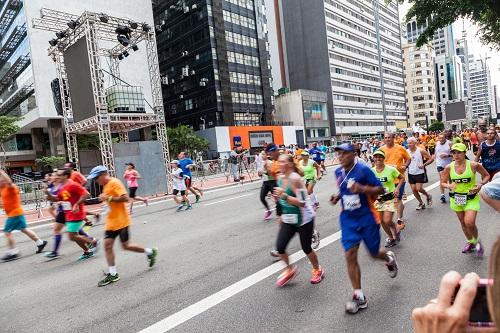

According to internal data from online race manager RunSignUp, the number of year-over-year race signup transactions returned to 2019 levels for the first time in a year — an indication that, as the company proclaims, “events are back.”
“There is, of course, still regional variability, and the largest events have mostly moved later in the year or decided to go virtual,” RunSignUp notes on its blog. “We expect more ups and downs. But as we did an informal survey of the country, we found Q1 live events in the vast majority of states, even in the dead of winter when events are scarce in the best of years.”
Here are a few trends RunSignUp is noticing:
• Hybrid races are happening everywhere. Even the Boston Marathon is offering a virtual version this year. These races offer the opportunity to expand participation to runners from all over the country and the world.
• Detailed safety precautions are a must. As RunSignUp warns, “[m]ost permitting agencies require a health safety plan for events to move forward.”
• Optimism abounds — especially for fall events. “With many marquee large events postponing to fall, we expect a highly saturated market then,” according to RunSignUp. “But people are looking for events now. Smaller events with the ability to modify to meet guidelines should work to maintain their normal spring/summer event dates while options are still limited for participants.”
• Big races are happening. Events with 10,000 or more runners are still on hold, but RunSignUp identified several events on the books for 2021 that can accommodate more than 1,000 participants. Additionally, at least 40 states are hosting live races in 2021.
California isn’t on that list -- yet. But it may be soon; in February, theCalifornia Coalition of Endurance Events — cofounded by a group of event owners and industry vendors — held a successful demonstration in Orange County for state and local government officials and media to demonstrate ways in which events like runs, triathlons, walks and bike rides can resume in a safe and responsible manner.
As Mike Bone, President and Chief Executive Officer of coalition member Spectrum Sports, told Running USA, the group’s goal is to educate decision-makers about the professionalism, lead times and positive economic impacts of the endurance industry, so that they can better understand the impact of shutting events down for prolonged periods.”
According to the coalition, the endurance sports industry generates more than $1 billion a year in tourism and economic activity in California, with more than $70 million in charitable contributions.
The coalition backed up its demonstration with a petition calling on “California’s elected leadership to follow the science and authorize immediately the safe, tiered re-opening of endurance events statewide.” As of April 6, it had generated almost 9,400 signatures, with a goal of 10,000.
“Immediate action is crucial because most endurance events take place on an annual basis and require extensive planning; thus, any further delay in re-opening threatens not only the short-term viability of upcoming 2021 events but the long-term viability of the businesses that produce these events,” according to the petition. “Endurance events are ideal for a safe, tiered re-opening, since they take place outdoors with participants in constant motion (i.e. built-in social distancing). Not only that, but race day practices can be modified to limit the number of people in any one place at a time, e.g. using rolling/staggered starts, re-imagined aid stations and no post-race party.”
The coalition also cited a Japanese study of 787 running events held in Japan in 2020 from July 1 to Oct 4. Only one virus case was reported in the two weeks following the event among a sample of nearly 670,000 athletes and officials. “By comparison, the odds of being struck by lightning in a given year are roughly one in 500,000,” the petition noted.
In Maine, the state’s Department of Economic and Community Development released a checklist in April that outlines safety parameters for such large gatherings as weddings and marathons.
“If this is what it means to be able to get out and run again against other people and be a part of those races and get those medals and get back to that kind of community aspect of running then we’re all for it,” Ian Tovell, a runner and personal trainer from Freeport, Maine, told WMTW.com.
The Albany Running Exchange in New York, hosted its Fall Classic in November with a 5K, a half-marathon and a full marathon, and its Electric City 5-Miler in March attracted 600 runners, according to the Poughkeepsie Journal, which noted that the race “featured 21 minutes of staggered starts, roughly six runners at a time.”
“It was our intent to create a spring kick-off event that would bring us safely together, with a festive atmosphere; one that would lift our spirits and remind us of how special and meaningful races can be,’’ Josh Merlis of the Albany Running Exchange wrote on Facebook. “And through our 600 runners, that was realized.’’

